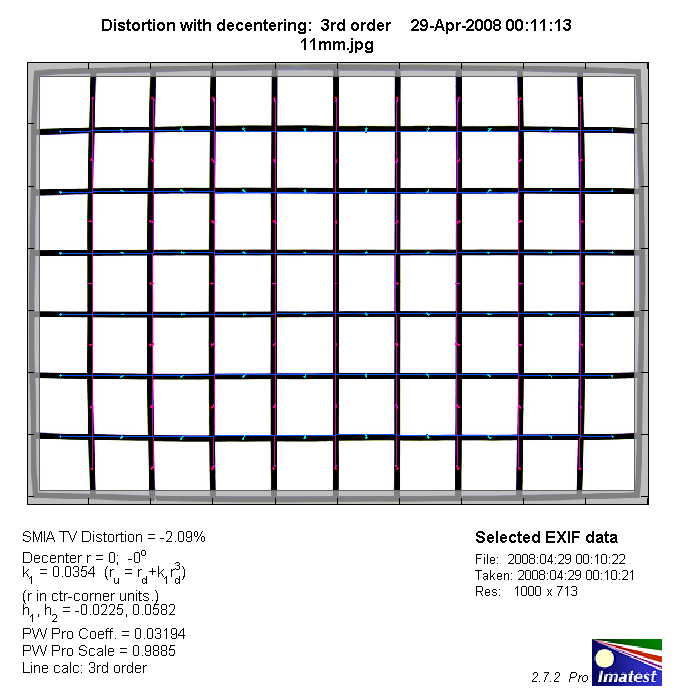|
Tokina AF 11-16mm f/2.8 AT-X Pro DX (Canon) - Review / Lab Test Report - Analysis |
|
Lens Reviews -
Canon EOS (APS-C)
|
|
Page 2 of 2

Distortion
Surprisingly Tokina managed to keep the level of distortion quite well under control. At 11mm there is a only moderate barrel distortion (2.1%) but this is still
comparatively low for such a lens. The problem decreases when zooming out towards the long end - at 14mm the barrel distortion is hardly objectionable anymore (1%) and basically negligible at 16mm (0.5%).
|
Move the mouse cursor over the focal length text marks below to observe the respective distortion
|
| 11mm |
14mm |
16mm |
|

|
We've reused the old charts here. The distortion characteristic cannot change just by using a different body with the same sensor size.
Vignetting
The vignetting characteristic of the Tokina is comparatively good for an ultra-wide angle lens. Unsurprisingly the problem is most pronounced at 11mm @ f/2.8 - a corner darkening of about 1.4EV (f-stops) will be visible in most scenes. However, beyond this setting the problem is well under control for such a lens. The light falloff is reduced at 14mm and 16mm but it still makes sense to stop down a little.

MTF (resolution)
The resolution figures of the Tokina are highly impressive and among the best that we've seen in this class. The center resolution is excellent throughout the range from f/2.8 till f/8. The border quality follows on a very high level. This is also mostly true for the extreme corners except for 16mm at max. aperture - basically the only weakness here but the corners are already sharp from f/4 onwards. Diffraction effects have a higher impact at and beyond f/11.
The field curvature is fairly moderate and not objectionable. The centering quality of the tested sample was good albeit not perfect.
Please note that the MTF results are not directly comparable across the different systems!
Below is a simplified summary of the formal findings. The chart shows line widths per picture height (LW/PH) which can be taken as a measure for sharpness.
If you want to know more about the MTF50 figures you may check out the corresponding Imatest Explanations
Chromatic Aberrations (CAs)
So far things looked bright but the lens has also a problem - lateral chromatic aberrations - visible as color shadows at harsh contrast transitions. The characteristic is uniformly high across the range with an average pixel width at 2.1-2.6px at the image borders. A typical flaw found in many Tokina lenses actually.

Sample Shots
You can find some sample images in the initial review of the lens.
VerdictThe Tokina AF 11-16mm f/2.8 AT-X Pro DX is an impressive ultra-wide zoom lens especially with respect to its resolution characteristic. It is extremely sharp at all zoom and aperture settings with the only exception of some corner softness at 16mm @ f/2.8. You can spot some light falloff at max. aperture specifically at the wide-end of the zoom range but the issue is already well controlled from f/4 onwards. The level of distortions is comparatively low for such a lens. Typical for most Tokina lenses it has one primary weakness: lateral CAs which are very high at all settings. However, remember that CAs can be corrected during post-processing in tools such as Photoshop or CaptureOne. The lens is also somewhat prone to flare.
Tokina lenses are renowned for the excellent build quality and the AF 11-16mm f/2.8 AT-X Pro DX is no exception to the rule. Everything feels solid and tightly assembled. The micro-motor AF is a bit on the dated side but the AF speed is actually fine and not really of primary concern on an ultra-wide lens anyway. All-in-all a very sound package especially when considering the quite affordable price of around 600-700EUR/US$. That said it faces rather stiff competition from the recently introduced Sigma AF 8-16mm f/4.5-5.6 EX HSM DC and the Canon EF-S 10-22mm f/3.5-4.5 USM is no slouch either.
|